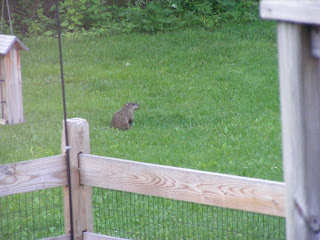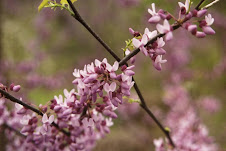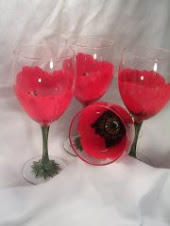
Fishing is just like farming, except there is no weeding to do, you can’t forget to water your seedlings, and you wear funny outfits that connote, “I am a superhero.” If you have ever seen someone in chest waders, this last phrase will make sense. If not, just imagine a grown man in tights with lots of gadgets hanging from a vest. Laura, my wife and host of this blog, particularly enjoys pointing out how ridiculous I look in said outfit. I digress. The point is… you don’t see many farmers in tights.
Now that I really think about it, there are actually very few similarities between fishing and farming. But, they do share one big thing in common. A meal prepared from either the produce just picked from your garden or the fish just caught from your stream is equally delicious.
A few weeks ago, I decided to combine the two when I hooked a rainbow trout in a pocket of fast water on the stream behind our house at 7PM and ate it at 8PM on a bed of organic field greens, paired with a grassy sauvignon blanc. Technically, the one hour from hook to table doesn’t count as a “30 Minute Meal,” but Rachel Ray isn’t gutting fish and harvesting greens during the ½ hour of pain she serves-up 10 times a day on the Food Network. So, one hour to prep and cook is ok by me.
This recipe is ideal for using-up all those cold weather garden products like radishes and greens before they grow too tough and bitter this summer. If you live by the sea, not the stream, the procedure and salad combination works well for striped bass, snapper, and other small saltwater species.
Baked Wild Trout with Field Greens and Radishes
To make the fish…
Ingredients:
1 Whole Wild Trout (extremely fresh, gutted)
2 Garlic Cloves (crushed)
1 Tarragon Sprig (bruised)
2 T. Extra Virgin Olive Oil
1 Lemon
Black Pepper (freshly cracked)
Salt to taste (sea, grey or kosher)
Procedure:
Preheat the oven to 450F. Place the trout on a baking sheet and coat with only 1 tablespoon of the oil. Sprinkle the exterior and the cavity of the fish with a pinch or two of salt, then stuff the cavity with the crushed garlic cloves and tarragon. Bake the fish at 450F for 20 minutes. Remove the fish from the oven and prepare for service by peeling back the skin (on one side of the fish only) to expose the flesh. Use a spoon to gently lift pieces of the flesh away from the bones, and place on a serving plate. When the one side is clean, gently pick-up the tail of the fish, thus pulling the bones in one big creepy skeleton off of the underside. Discard the bones or use them to make fish stock. Then, use the spoon again to pull the newly exposed flesh from the skin, and place on the serving plate. Finish by drizzling the remaining oil over the fish pieces, then add a squeeze of lemon, a touch of pepper and adjust the salt to taste.
To make the salad…
Ingredients:
Now that I really think about it, there are actually very few similarities between fishing and farming. But, they do share one big thing in common. A meal prepared from either the produce just picked from your garden or the fish just caught from your stream is equally delicious.
A few weeks ago, I decided to combine the two when I hooked a rainbow trout in a pocket of fast water on the stream behind our house at 7PM and ate it at 8PM on a bed of organic field greens, paired with a grassy sauvignon blanc. Technically, the one hour from hook to table doesn’t count as a “30 Minute Meal,” but Rachel Ray isn’t gutting fish and harvesting greens during the ½ hour of pain she serves-up 10 times a day on the Food Network. So, one hour to prep and cook is ok by me.
This recipe is ideal for using-up all those cold weather garden products like radishes and greens before they grow too tough and bitter this summer. If you live by the sea, not the stream, the procedure and salad combination works well for striped bass, snapper, and other small saltwater species.
Baked Wild Trout with Field Greens and Radishes
To make the fish…

Ingredients:
1 Whole Wild Trout (extremely fresh, gutted)
2 Garlic Cloves (crushed)
1 Tarragon Sprig (bruised)
2 T. Extra Virgin Olive Oil
1 Lemon
Black Pepper (freshly cracked)
Salt to taste (sea, grey or kosher)
Procedure:
Preheat the oven to 450F. Place the trout on a baking sheet and coat with only 1 tablespoon of the oil. Sprinkle the exterior and the cavity of the fish with a pinch or two of salt, then stuff the cavity with the crushed garlic cloves and tarragon. Bake the fish at 450F for 20 minutes. Remove the fish from the oven and prepare for service by peeling back the skin (on one side of the fish only) to expose the flesh. Use a spoon to gently lift pieces of the flesh away from the bones, and place on a serving plate. When the one side is clean, gently pick-up the tail of the fish, thus pulling the bones in one big creepy skeleton off of the underside. Discard the bones or use them to make fish stock. Then, use the spoon again to pull the newly exposed flesh from the skin, and place on the serving plate. Finish by drizzling the remaining oil over the fish pieces, then add a squeeze of lemon, a touch of pepper and adjust the salt to taste.
To make the salad…
Ingredients:

Mixed Field Greens (about 4 loose cups)
3 Radishes
1/3 Cup Extra Virgin Olive Oil
1 Lemon (juice and zest)
1 T. Dijon Mustard
Black Pepper (freshly cracked)
Salt to taste (sea, grey or kosher)
Procedure:
In a large, non-reactive bowl, make the dressing by whisking the mustard, lemon zest and juice to combine. Slowly add the oil while whisking to create an emulsion. Adjust the seasoning with salt and pepper, and set aside. Select a mix of field greens. (For my 8PM trout dinner, I chose a combination of romaine, oak leaf, endive and arugula, all from the garden. My father is particularly fond of a mix called, in Italian, “tre colore,” consisting of arugula, radicchio and Belgian endive. But, anything you like is appropriate.) Cut the radishes into matchstick size strips. Add the radishes and greens into the bowl with the dressing and toss gently to coat. Serve immediately.
3 Radishes
1/3 Cup Extra Virgin Olive Oil
1 Lemon (juice and zest)
1 T. Dijon Mustard
Black Pepper (freshly cracked)
Salt to taste (sea, grey or kosher)
Procedure:
In a large, non-reactive bowl, make the dressing by whisking the mustard, lemon zest and juice to combine. Slowly add the oil while whisking to create an emulsion. Adjust the seasoning with salt and pepper, and set aside. Select a mix of field greens. (For my 8PM trout dinner, I chose a combination of romaine, oak leaf, endive and arugula, all from the garden. My father is particularly fond of a mix called, in Italian, “tre colore,” consisting of arugula, radicchio and Belgian endive. But, anything you like is appropriate.) Cut the radishes into matchstick size strips. Add the radishes and greens into the bowl with the dressing and toss gently to coat. Serve immediately.


 Now it’s picture and basket recipe time!
Now it’s picture and basket recipe time!










.jpeg)



